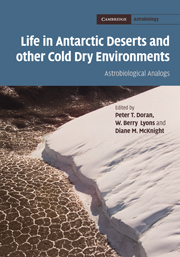Book contents
- Frontmatter
- Contents
- List of contributors
- 1 Introduction
- 2 Geologic analogies between the surface of Mars and the McMurdo Dry Valleys: microclimate-related geomorphic features and evidence for climate change
- 3 The legacy of aqueous environments on soils of the McMurdo Dry Valleys: contexts for future exploration of martian soils
- 4 The antarctic cryptoendolithic microbial ecosystem
- 5 Antarctic McMurdo Dry Valley stream ecosystems as analog to fluvial systems on Mars
- 6 Saline lakes and ponds in the McMurdo Dry Valleys: ecological analogs to martian paleolake environments
- 7 The biogeochemistry and hydrology of McMurdo Dry Valley glaciers: is there life on martian ice now?
- 8 Factors promoting microbial diversity in the McMurdo Dry Valleys, Antarctica
- 9 Other analogs to Mars: high-altitude, subsurface, desert, and polar environments
- Index
- References
3 - The legacy of aqueous environments on soils of the McMurdo Dry Valleys: contexts for future exploration of martian soils
Published online by Cambridge University Press: 06 July 2010
- Frontmatter
- Contents
- List of contributors
- 1 Introduction
- 2 Geologic analogies between the surface of Mars and the McMurdo Dry Valleys: microclimate-related geomorphic features and evidence for climate change
- 3 The legacy of aqueous environments on soils of the McMurdo Dry Valleys: contexts for future exploration of martian soils
- 4 The antarctic cryptoendolithic microbial ecosystem
- 5 Antarctic McMurdo Dry Valley stream ecosystems as analog to fluvial systems on Mars
- 6 Saline lakes and ponds in the McMurdo Dry Valleys: ecological analogs to martian paleolake environments
- 7 The biogeochemistry and hydrology of McMurdo Dry Valley glaciers: is there life on martian ice now?
- 8 Factors promoting microbial diversity in the McMurdo Dry Valleys, Antarctica
- 9 Other analogs to Mars: high-altitude, subsurface, desert, and polar environments
- Index
- References
Summary
Introduction
The McMurdo Dry Valleys are the largest and one of the most southernly exposed terrestrial antarctic environments (Ugolini and Bockheim,2008) and have been a prominent analog environment for speculations about surface processes (Mahaney et al., 2001; Dickenson and Rosen, 2003; Marchant and Head, 2007) and potential biology (McKay, 1997; Wynn-Williams and Edwards, 2000) on Mars. The extremes in cold and aridity, the paucity of visually conspicuous life forms, and the undisturbed conditions of the McMurdo Dry Valleys make this region an obvious candidate for such comparisons. Recent discoveries of evidence demonstrating past and perhaps present availability of liquid water on the martian surface detected by the Mars Global Surveyor (Malin and Edgett, 2000; Baker, 2001) and the Spirit and Opportunity rovers (Squires et al., 2004a; Haskin et al., 2005) have extended the foundation of these comparisons beyond similarities in climate to surface geomorphology, geochemistry, and mineralogy (Chevrier et al., 2006; Marchant and Head, 2007; Amundson et al., 2008).
Water is the primary limitation to geochemical weathering and biological activity in the McMurdo Dry Valleys of Antarctica and other cold desert ecosystems where availability and movement of liquid water is limited by low temperatures (Kennedy, 1993; Convey et al., 2003; Barrett et al., 2008). This limitation of liquid water results in slow weathering and highly constrained biological activity contributing to relatively stable geochemical conditions in surface environments. Thus, in the McMurdo Dry Valleys, the legacy of paleo-aquatic environments is preserved in contemporary patterns of soil geochemistry.
- Type
- Chapter
- Information
- Life in Antarctic Deserts and other Cold Dry EnvironmentsAstrobiological Analogs, pp. 78 - 109Publisher: Cambridge University PressPrint publication year: 2010
References
- 3
- Cited by

